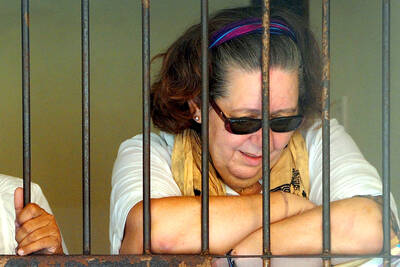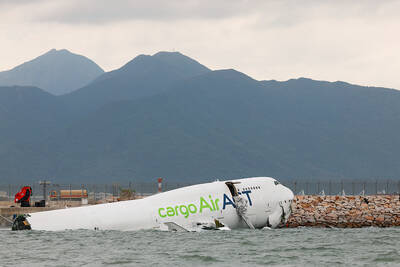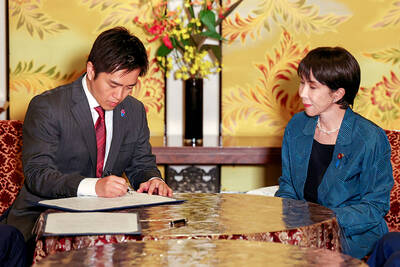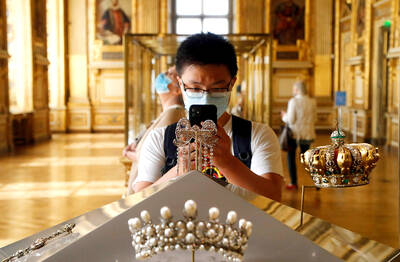Far below Mount Ararat’s snow-covered peak, history weighs heavy on the shoulders of Turks and Armenians seeking to overcome animosity generated by genocide claims and territorial disputes.
A recent diplomatic initiative to restore ties between the arch foes has fueled hopes of economic and strategic benefits. It has also stirred up century-old distrust and fears among locals as they watch developments from the militarized frontier.
The distrust of many in Turkey’s Igdir Province is illustrated by a monument near Ararat consisting of five 40m-tall swords thrust toward the sky. It commemorates the killing of Turks by Armenians during and after World War I.
The memorial is a riposte to Armenian claims, supported by many countries and academics, that Ottoman Turk forces killed 1.5 million Armenians in a 1915 genocide that is commemorated across the border in Armenia on April 24.
“In Igdir there are still living witnesses who tell their descendants about the killings by Armenians here,” said Goksel Gulbeyi, chairman of an association set up to refute Armenian genocide claims.
Turkey fiercely rejects the genocide charge, saying many were killed on both sides during the conflict.
“There are people here who still feel resentment. The border shouldn’t be reopened until they are reassured,” he said.
At the Alican border gate 15km away, soldiers send journalists away while farmers dig in surrounding land.
Gulbeyi’s group has launched a campaign to block the reopening of the border, closed by Turkey in 1993 in support of its traditional Muslim ally Azerbaijan, which was fighting Armenian-backed separatists in the breakaway mountain region of Nagorno-Karabakh.
Turkish Prime Minister Tayyip Erdogan said this month the deadlock over Nagorno-Karabakh, where a fragile ceasefire holds but a peace accord has never been signed, should be resolved before any deal is struck between Turkey and Armenia.
There are also fears in Igdir, which has a large Azeri population, that Armenia covets Turkish territory. Mount Ararat, which provides a backdrop to the capital Yerevan, is a national symbol of Armenia and is pictured on its currency.
A breakthrough between Turkey and Armenia could help shore up stability in the Caucasus, criss-crossed by oil and gas pipelines which make it of strategic importance to Russia, Europe and the US.
Western diplomats are concerned that in retaliation for the border reopening, Azerbaijan might be unwilling to sell its gas in the future through Turkey to Europe, and instead send most of it to Russia for re-export.
Despite the concerns, tentative cross-border contacts have generated fragile optimism among many in eastern Turkey, where livelihoods are largely made from farming and where per capita income is around a tenth of levels in affluent western Turkey.
“We want peace. I went to Armenia and I was received very well. We show them hospitality when they come here. I think it would be good for our economy and trade if the border opens,” said Ali Guvensoy, chairman of the Kars Chamber of Commerce.
That optimism is shared in landlocked Armenia. A reopening of the border would provide a huge boost to the economy, having already lost out on lucrative energy transit deals and trade with eastern Turkey.
Armenian President Serzh Sarksyan has said he expects the border to reopen by the time he attends a football match between the two countries in October.
Last year, President Abdullah Gul became the first Turkish leader to visit Armenia when he attended the first of the two World Cup qualifying ties between the two countries.
US President Barack Obama, who visited NATO ally Turkey this month, has urged Turkey to normalize ties with Armenia. The EU has said such ties would help Turkey’s bid to join the bloc.
Obama, who as a candidate labelled the killings genocide, said during his visit that he stood by his views, but said he did not want to obstruct the Turkish-Armenian rapprochement.
“I think Mr Obama and the United States must intervene and solve the problems between the two countries so the border can be opened,” Guvensoy said.

Indonesia was to sign an agreement to repatriate two British nationals, including a grandmother languishing on death row for drug-related crimes, an Indonesian government source said yesterday. “The practical arrangement will be signed today. The transfer will be done immediately after the technical side of the transfer is agreed,” the source said, identifying Lindsay Sandiford and 35-year-old Shahab Shahabadi as the people being transferred. Sandiford, a grandmother, was sentenced to death on the island of Bali in 2013 after she was convicted of trafficking drugs. Customs officers found cocaine worth an estimated US$2.14 million hidden in a false bottom in Sandiford’s suitcase when

CAUSE UNKNOWN: Weather and runway conditions were suitable for flight operations at the time of the accident, and no distress signal was sent, authorities said A cargo aircraft skidded off the runway into the sea at Hong Kong International Airport early yesterday, killing two ground crew in a patrol car, in one of the worst accidents in the airport’s 27-year history. The incident occurred at about 3:50am, when the plane is suspected to have lost control upon landing, veering off the runway and crashing through a fence, the Airport Authority Hong Kong said. The jet hit a security patrol car on the perimeter road outside the runway zone, which then fell into the water, it said in a statement. The four crew members on the plane, which

Japan’s ruling Liberal Democratic Party (LDP) and its junior partner yesterday signed a coalition deal, paving the way for Sanae Takaichi to become the nation’s first female prime minister. The 11th-hour agreement with the Japan Innovation Party (JIP) came just a day before the lower house was due to vote on Takaichi’s appointment as the fifth prime minister in as many years. If she wins, she will take office the same day. “I’m very much looking forward to working with you on efforts to make Japan’s economy stronger, and to reshape Japan as a country that can be responsible for future generations,”

SEVEN-MINUTE HEIST: The masked thieves stole nine pieces of 19th-century jewelry, including a crown, which they dropped and damaged as they made their escape The hunt was on yesterday for the band of thieves who stole eight priceless royal pieces of jewelry from the Louvre Museum in the heart of Paris in broad daylight. Officials said a team of 60 investigators was working on the theory that the raid was planned and executed by an organized crime group. The heist reignited a row over a lack of security in France’s museums, with French Minister of Justice yesterday admitting to security flaws in protecting the Louvre. “What is certain is that we have failed, since people were able to park a furniture hoist in the middle of